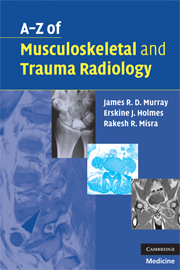Book contents
- Frontmatter
- Contents
- Acknowledgements
- Preface
- List of abbreviations
- Section I Musculoskeletal radiology
- Achilles tendonopathy/rupture
- Aneurysmal bone cysts
- Ankylosing spondylitis
- Avascular necrosis – osteonecrosis
- Femoral-head osteonecrosis
- Kienböck's disease
- Back pain – including spondylolisthesis/spondylolysis
- Bone cysts
- Bone infarcts (medullary)
- Charcot joint (neuropathic joint)
- Complex regional-pain syndrome
- Crystal deposition disorders
- Developmental dysplasia of the hip (DDH)
- Discitis and vertebral osteomyelitis
- Disc prolapse – PID – ‘slipped discs’ and sciatica
- Diffuse idiopathic skeletal hyperostosis (DISH)
- Dysplasia – developmental disorders
- Enthesopathy
- Gout
- Haemophilia
- Hyperparathyroidism
- Hypertrophic pulmonary osteoarthropathy
- Irritable hip/transient synovitis
- Juvenile idiopathic arthritis
- Langerhans-cell histiocytosis
- Lymphoma of bone
- Metastases to bone
- Multiple myeloma
- Myositis ossificans
- Non-accidental injury
- Osteoarthrosis – osteoarthritis
- Osteochondroses
- Osteomyelitis (acute)
- Osteoporosis
- Paget's disease
- Perthes disease
- Pigmented villonodular synovitis (PVNS)
- Psoriatic arthropathy
- Renal osteodystrophy (including osteomalacia)
- Rheumatoid arthritis
- Rickets
- Rotator-cuff disease
- Scoliosis
- Scheuermann's disease
- Septic arthritis – native and prosthetic joints
- Sickle-cell anaemia
- Slipped upper femoral epiphysis (SUFE)
- Tendinopathy – tendonitis
- Tuberculosis
- Tumours of bone (benign and malignant)
- Section II Trauma radiology
Bone infarcts (medullary)
from Section I - Musculoskeletal radiology
Published online by Cambridge University Press: 22 August 2009
- Frontmatter
- Contents
- Acknowledgements
- Preface
- List of abbreviations
- Section I Musculoskeletal radiology
- Achilles tendonopathy/rupture
- Aneurysmal bone cysts
- Ankylosing spondylitis
- Avascular necrosis – osteonecrosis
- Femoral-head osteonecrosis
- Kienböck's disease
- Back pain – including spondylolisthesis/spondylolysis
- Bone cysts
- Bone infarcts (medullary)
- Charcot joint (neuropathic joint)
- Complex regional-pain syndrome
- Crystal deposition disorders
- Developmental dysplasia of the hip (DDH)
- Discitis and vertebral osteomyelitis
- Disc prolapse – PID – ‘slipped discs’ and sciatica
- Diffuse idiopathic skeletal hyperostosis (DISH)
- Dysplasia – developmental disorders
- Enthesopathy
- Gout
- Haemophilia
- Hyperparathyroidism
- Hypertrophic pulmonary osteoarthropathy
- Irritable hip/transient synovitis
- Juvenile idiopathic arthritis
- Langerhans-cell histiocytosis
- Lymphoma of bone
- Metastases to bone
- Multiple myeloma
- Myositis ossificans
- Non-accidental injury
- Osteoarthrosis – osteoarthritis
- Osteochondroses
- Osteomyelitis (acute)
- Osteoporosis
- Paget's disease
- Perthes disease
- Pigmented villonodular synovitis (PVNS)
- Psoriatic arthropathy
- Renal osteodystrophy (including osteomalacia)
- Rheumatoid arthritis
- Rickets
- Rotator-cuff disease
- Scoliosis
- Scheuermann's disease
- Septic arthritis – native and prosthetic joints
- Sickle-cell anaemia
- Slipped upper femoral epiphysis (SUFE)
- Tendinopathy – tendonitis
- Tuberculosis
- Tumours of bone (benign and malignant)
- Section II Trauma radiology
Summary
Characteristics
Idiopathic bone infarcts characteristically occur in long-bone metaphyses.
Histological testing reveals mineralisation of necrotic marrow.
Aetiology is likely to be related to intrinsic/extrinsic vascular compromise such as thrombosis, arteritis, atherosclerosis or external compression (fractures, oedema, tumour, etc).
Clinical features
Classically asymptomatic and discovered as an incidental diagnosis.
Radiological features
Early rarefaction followed by sclerosis, calcification, and ossification parallel to the cortex in the healing phase.
Bone scan – ‘cold spot’ or no increased uptake in the early stages; becomes ‘hot’ as revascularisation occurs.
Management
No treatment is required; however, malignant fibrous histiocytoma has been reported developing in previous bone infarcts.
Bone islands
Characteristics
Histologically these are markedly thickened bony trabeculae.
Seen in all ages.
Unknown aetiology but may represent a developmental anomaly.
Usually solitary, commonest in the proximal femur and ilium.
Clinical features
Asymptomatic – incidental diagnosis, but these are important in the differential diagnosis of more sinister lesions.
Radiological features
Sclerotic areas within bone which are well demarcated from surrounding normal bone (narrow zone transition). Classically the margin appears feathery.
No cortical involvement or periosteal reaction.
Often oval with the long axis parallel to the bone.
Bone scan – if large may show increased uptake.
Management
Exclude more sinister pathology, but no particular treatment is required.
- Type
- Chapter
- Information
- A-Z of Musculoskeletal and Trauma Radiology , pp. 29 - 33Publisher: Cambridge University PressPrint publication year: 2008

